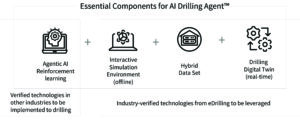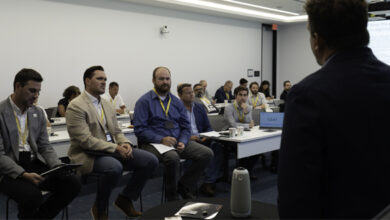eDrilling kicks off ambitious R&D project leveraging agentic AI to develop a ‘drilling agent’
Emerging field within AI targets systems that act independently without human intervention, could help realize fully autonomous drilling

By Jessica Whiteside, Contributor
Software developer eDrilling has launched its most ambitious R&D project yet: an AI system that’s designed to boost the safety and efficiency of drilling operations by automating complex tasks across all rig and well types. While eDrilling is still in the initial stages of developing this “AI drilling agent” software, the company’s ultimate vision is to enable fully autonomous drilling.
“The objective is to develop an AI drilling agent that would behave just like experienced engineers to make autonomous decisions and optimize those decisions,” said Jie Cao, Chief Technology Officer at eDrilling. Tripping speed, weight on bit and rate of penetration (ROP) are among the parameters the AI drilling agent could assess while tweaking operational strategy in real time as it determines the best strategy to total depth.
Companies in the drilling space are increasingly turning to AI-powered tools to support data analysis and decision making, and eDrilling itself has been applying AI technology to drilling operations since 2008.
So, what makes the AI drilling agent project different from the company’s previous engineering efforts? The answer lies in the emerging field of agentic AI.
Agentic AI explained
The industry has the hardware for autonomous drilling but has been lacking the software “brain” needed to support truly autonomous drilling, Dr Cao said. Enter agentic AI, which is more independent and adaptable than traditional AI models. Software featuring agentic AI has the potential to learn, reason, strategize and choose which actions it will take to meet complex goals in dynamic environments with little human direction. On a rig, for example, rather than simply alerting a human operator to a data anomaly that could signify a hazard, an agentic AI system could conceivably make proactive adjustments to mitigate the hazard without human intervention.
The real-world application of agentic AI is still in its infancy but advancing rapidly, particularly in fields such as IT, finance and manufacturing. To develop the AI drilling agent, eDrilling will integrate agentic AI with some of its established AI, machine learning and physics-based modeling solutions, including automated monitoring and advisory software, dynamic drilling simulators and digital twins. These will be the essential components in developing the AI drilling agent.
“This is not something we’re going to build from zero,” Dr Cao said. “It’s based on our existing, mainly physics-based modeling approach that’s been verified by use in the industry for three decades.” Those user cases with data and calibrated models will serve as a library for the agent to explore, learn and generalize knowledge for future applications.
Reliability and the big picture
Designed to be an assistant to the drilling engineer, the AI drilling agent would be capable of adapting independently to changing conditions while managing repetitive operational tasks, allowing the human expert to focus on more high-value activities. While eDrilling plans to endow the Agent with the mechanisms needed to make autonomous decisions, the level of automation and autonomy would be up to the operator. The company expects that most users would, at least initially, choose to maintain a degree of human supervision. The human operator’s role would shift to oversight of the AI system.
“Even with the technology ready, it doesn’t mean that everyone will purely rely on it, because in the drilling industry, we always put safety as the first priority. We want to still have some possibility for human experts to intervene when something is not clear or is uncertain,” Dr Cao said.
The developers also want the agent to be cognitive, meaning it should be aware of the status of the drilling operation, what the next sequence will be, and what the entire operation entails. Predictive analysis will enable the agent to think ahead and consider multiple “what if” scenarios. This ability to determine the most effective strategy for the entire well, not just the next stand, is one feature that will set the AI drilling agent concept apart from current technology, Dr Cao said.
To ensure that the agent’s recommendations fall within the margins of safe operations, it will be programmed to be aware of any rig or equipment limitations. It will also disclose when it has insufficient knowledge to provide a reliable answer, an important trait for building user trust in the system. In addition, its decisions will be interpretable: Agentic AI will enable the drilling agent to explain to users why it has reached a certain conclusion.
“For example, if the agent suggests a risk control strategy, the engineer can either accept that recommendation or reject it by questioning, ‘I don’t quite believe in that. Can you show me why you reached that decision?’ ” Dr Cao said. “This interpretability would make engineers more comfortable and confident about working collaboratively with an AI drilling agent. The engineer can reason with the agent, and the agent can learn from the engineer’s feedback.”

Hybrid approach
A key feature of agentic AI is its capacity for continuous, independent learning. eDrilling intends for the agent to be a lifelong — and self-teaching — learner that improves iteratively over time with each new situation it encounters. This includes adapting to new tools and workflows introduced on the rig.
“The AI drilling agent will be a learning machine. Every time you use it, it will learn from that case,” Dr Cao said.
The agent’s training will start with the fundamentals of drilling, including roles, operational sequences and the physics behind the drilling process. To ensure it’s not just a rookie but has knowledge of historical drilling cases, it will be exposed to hybrid data sets comprising both data and models. The agent will also gain offline experience with diverse types of operations through eDrilling’s interactive well simulator.
“Just like an engineer, the agent can interact with this simulation environment and explore what the best decision would be at a certain point in an operation,” Dr Cao said. “It’s like we made a computer game called Drilling, and the goal is to reach the target in a faster way while maintaining safety. Now, instead of training a person to do that, we are trying to train the agent to do the job automatically.”
The company will also use digital twin technology to provide real-time modeling support to the agent to help it make predictions and conduct verifications of recommended strategies. Because the agent will inevitably encounter uncertain conditions in the real world, it will leverage real-time calibrated digital twins to adapt to new scenarios. These technologies, together with reinforcement learning algorithms, will equip the agent to reason out the optimal sequential steps to achieve multiple objectives.
“For example, while drilling we may want to pursue as high an ROP as possible. But meanwhile, we need to maintain borehole stability and good wellbore cleaning. With these combined objectives, the AI drilling agent would use its pre-training and predictive analysis to search every possibility to suggest the best strategy,” Mr Cao said. Once the agent has undergone extensive learning and training processes, the agent will be the most experienced drilling engineer to advise. Upon deployment, it continues to learn and customize its advisory to meet the specific needs and preferences of individual users/groups.
Agnostic deployment
eDrilling plans to make the AI drilling agent agnostic in terms of the types of rigs, wells and sectors it serves, targeting not only oil and gas drilling but also geothermal and carbon capture and storage projects. The company even sees a need for autonomous drilling as part of future space exploration on Mars or the Moon.
“It would be applicable for all kinds of technology, every vendor and for different types of operations,” Dr Cao said. “Our main objective is to achieve technology democracy. We want this agent to be easily and seamlessly deployed on any rig, for any well. That’s how we can really revolutionize drilling operations through AI.”
Will a rig need to be highly advanced already with all the latest sensors to use the AI drilling agent? Not necessarily, as one of the project’s design principles is to avoid the need for additional hardware beyond a computer or laptop, said Caroline Vorpenes, CEO of eDrilling.
“Whether you have the most fantastic drillship with all the latest and greatest equipment and wired pipe, or whether you have a very simple land rig, you will get the advice of AI to your drilling operations,” she said. “We want this to be the companion to every driller and every drilling engineer, everywhere.”
At a time when many of the industry’s most experienced drilling engineers are retiring and taking their immense knowledge with them, Ms Vorpenes sees the AI drilling agent as “a fantastic technology to help young drilling engineers more than anything else. It’s turning this thinking that AI will steal people’s jobs into a realization that AI will actually help people do the job much better. That’s the mindset we’re applying to how we will develop the product.”
The company is aiming to have the full version of the AI drilling agent ready for the market in approximately two-and-a-half years but plans to release a minimum marketable product for users to try out before then. The project is in the first phase of a four-phase software development plan that will advance the system from student to expert adviser.
To help it effect this transformation, eDrilling is seeking partners from across the drilling sector to ensure it has sufficient global data and testing opportunities to train the AI drilling agent on all drilling methods, operations and environments. DC




